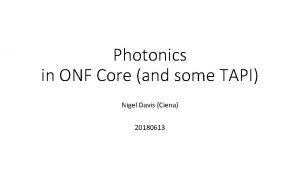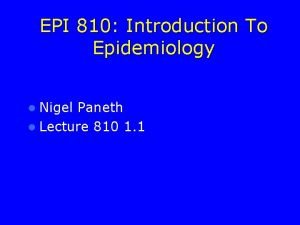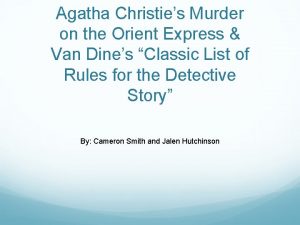Murder on the Orient Express Analysis Nigel Allen
















- Slides: 16

Murder on the Orient Express Analysis Nigel Allen & Noah Atkins

Vocabulary Part 1 Hymeneal- of or pertaining to marriage. Suffice-to equal or adequate, as for needs, purposes etc. Arithmetic- the method or process of computation with figures. ouija- the spiritual board where the medium moves ones fingers to the letters to answers question. Prominent- standing out to be seen easily.

Vocabulary Part 2 • • • Expenditure- the way something is used up, or spent. Onus- a difficult task or burden. Irremediably- not easily cured, or fixed. Verisimilitude- having the appearance of truth or probability. Hoodwink- to deceive or trick

Van Dine's Rules 1 -3 1. The reader and the detective must have an equal chance to solve the case, so every single detail needs to be apparent. 2. No character should be able to trick the reader, except for the criminal and his or her tricks on the detective himself. 3. There can be no love interest of any kind. The detective is supposed to solve the case and bring the criminal to justice, not fall in love.

Van Dine's Rules 4 -5 4. The detective himself should never be the criminal, because it provides the reader with false pretenses. 5. The detective should determine the culprit through, logic. No accidents or coincidences should make the solution clear! It's similar to a man saying he has a prize hidden in the room, but having it in his pocket.

Van Dine's Rules 6 -7 6. The detective in the book must be a detective. He is not a detective unless he detects. That means he must find clues and use logic to find the criminal. 7. There must be a person that has died and his corpse must be left behind for evidence.

Van Dine's Rules 8 -9 8. The crime needs to be solved through physical facts and energy, meaning no supernatural practices, such as mindreading, may be used. If the reader has to explore those possibilities, as well, he or she would be incapable of reaching a solution. 9. There can only be one lone detective on the case, rather than a team. This would put the reader at a disadvantage, because he or she wouldn't be able to keep up.

Van Dine's Rules 10 -12 10. The culprit has to have played a significant part in the development of the plot, meaning the culprit can't be an old woman who'd passed the victim on the street. 11. The author should not have a servant commit a crime. It's quite the overused scenario; it is way too obvious a solution. 12. Only a single person may be the guilty party, regardless of the number of crimes. The reader needs to focus on one personality.

Van Dine's Rules 13 -14 13. Secretive organizations, including mafias and gangs, have no business in detective stories. The culprit shouldn't have a secret society to resort to when the detective is getting close. 14. Only realistic and ordinary tactics may be implemented in the novel. Adding in aliens, monsters, and the like reaches into detective fiction.

Van Dine's Rules 15 -17 15. Throughout the story, the solution needs to be clear enough to be seen at all times, given the reader is clever enough to see it or rereads the novel. 16. Intricate details regarding the setting or other small details, such as the wall color or clothes of a character, have no business in a detective novel. 17. Professional criminals in the novel shouldn't have any type of guilt or remorse.

Van Dine's Rules 18 -20 18. The crime in the novel must never turn out to be an accident or suicide. This wastes the reader's efforts. 19. The motives for any crime in the story should all be personal. International and war -related crimes don't quite fit in with detective stories. 20. Commonly used techniques, such as comparing cigarettes, intimidating the culprit, fake fingerprints, or having the culprit be a twin should never be used.

Rule #7 Murder on the Orient Express fits in with Van Dine's seventh rule for detective novel, especially in part on e. chapter five, when Christie wrote, "And now a passenger lies dead in his birth-stabbed"(Christie 40), and rule #7 states that a person has to have died, the corpse left to be found.

Rule #4 Christie's Murder on the Orient Express agrees with Van Dine's fourth rule for detective novels, because none of the officials in charge of solving the murder turned out to be the culprit, which Van Dine said wasn't appropriate for detective books.

Rule #10 The novel also abides by Van Dine's tenth rule, which simply says that the culprit must have had time for character development. In the story, all of the character who were questioned were guilty, excluding the Countess, so technically, the culprit played a prominent role.

Rule #18 Since Van Dine's eighteenth rule states that the crime can't turn out to be an accident, this novel obeys the rule. "And now a passenger lies dead in his birthstabbed"(Christie 40), explains that Ratchett didn't die peacefully, or suffer any accident.

Rule #19 The nineteenth rule for detective stories, as depicted by Van Dine, states that the murderer's motive must be personal. "Do you remember reading of the Armstrong baby? This is the man who murdered little Daisy Armstrong. Casetti" ( Christie 65), explains that Ratchett was a murderer, and that someone could be out for revenge.
 Murder on the orient express analysis
Murder on the orient express analysis Murder on the orient express analysis
Murder on the orient express analysis Orient express
Orient express Ein gleiches analyse
Ein gleiches analyse Orient ezan cihazı
Orient ezan cihazı Spur land nav
Spur land nav Lensatic definition
Lensatic definition Orient east med corridor
Orient east med corridor Orient east med corridor
Orient east med corridor Orient east med corridor
Orient east med corridor Tactical communications
Tactical communications Nigel reuel
Nigel reuel Cristen chin model
Cristen chin model Nigel tapi
Nigel tapi Nigel holland taylor wimpey
Nigel holland taylor wimpey Nigel price md
Nigel price md Nigel paneth md
Nigel paneth md





























